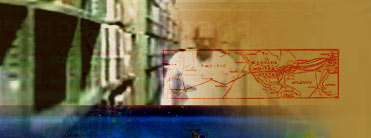SEPARATE LIVES, BROKEN DREAMS
CHINESE EXCLUSION ERA CASE FILES
Of the National Archives and Records Administration
In 1882, with a stroke of President Chester Arthur's pen, the Chinese Exclusion Act became the first race-based immigration law in U.S. history. However, interpreting and enforcing its restrictions was yet another matter. Legions of inspectors, medical examiners, interpreters, stenographers, guards and matrons were now required to implement and record every aspect of the exclusion process against the Chinese. Indeed, the Chinese Exclusion Act was instrumental in the eventual creation and evolution of one of America's biggest bureaucracies, the Immigration and Naturalization Service (I.N.S.).
The Chinese now became the most "over documented" immigrants ever to attempt entry into America. Every individual, with 50% Chinese blood or more, was subject to extensive interrogations and forced to provide evidence as to their exempt status. Determining who was prohibited from entry and who was exempt from exclusion was no easy task. Since the Chinese considered exclusion to be extremely unjust and discriminatory, many resorted to circumventing its policies in any manner possible. Entering Chinese would claim, whether legitimately or with falsified documents and contrived identities, to be merchants, U.S. Citizens, or the relations of other similarly exempt classifications of Chinese.
All this elaborate documentation, meticulously compiled by a variety of government agencies, are now stored with the National Archives and Records Administration (NARA). They include individual case files of every Chinese person who entered, departed, returned and/or was deported during the Exclusion era. The NARA - Pacific Region facilities in San Bruno, California alone hold over a quarter of a million individual case files from the Port of San Francisco and Hawaii. This facility is only one of 14 NARA Regional branches located throughout the United States where federal archival records are available for public access (see NARA section of this web site for more information and related links).
The Chinese Exclusion era case files are without a doubt some of the most fascinating and richest historical records in the world. They reveal the deep impact that exclusion had on individual lives, family relations and communities here in America and abroad, as well as the broad ramifications it had on issues of national policy and foreign relations. As aging immigrants from this historic period fade away, their case files may be all that remains to testify to both the triumph and disappointment of their journey to America under exclusion.
EXAMINING NARA CASE FILES
When examining the Chinese Exclusion era case files at this web site, it is important to keep in mind that this particular on-line program only presents select excerpts from each file. Consider it the "tip" of a very, very large "ice berg". It is not uncommon for a complex case to be (almost a half-inch or more thick) full of documents, photos and/or artifacts. One interrogation transcript alone can run over 20 pages in length (and be available in multiple carbon copies)! The intent here is to provide you with just a hint of the richness and diversity of material available. Consider it an "appetizer" that can lead one to a "multi-course banquet" if one is so inclined to search out and access these and other Chinese Exclusion Act Era cases for themselves at the National Archives (which is certainly our hope, see NARA section of this web site).
Many people often consider history as a collection of dry facts, figures and events. In actuality, the study of history involves a very pro-active process of investigation, analysis, interpretation, and even speculation. When viewing a typical NARA case file, it is important to consider the sequence of events and the point of view being presented. You are unraveling an ever-evolving story. Different documents present different points of view, that of a government official weighing different testimony and evidence or that of an immigrant arguing his/her case for entry. As you review a file from beginning to end, you may find your own personal experience mirroring that of the dilemma faced by many immigration officials during exclusion. It is often difficult to distinguish fact from fiction. You begin to detect discrepancies in the testimony. You find yourself trying to piece together a multi-faceted "puzzle" where perhaps there is no conclusive evidence either way to support a clear-cut determination.
Nevertheless, in every case, someone eventually had to make a life altering decision and someone had to bear the consequences. All things considered, an examination of history is perhaps very much like the process of determining the destiny of any one Chinese immigrant during the Era of exclusion. It relies largely on point of view.





